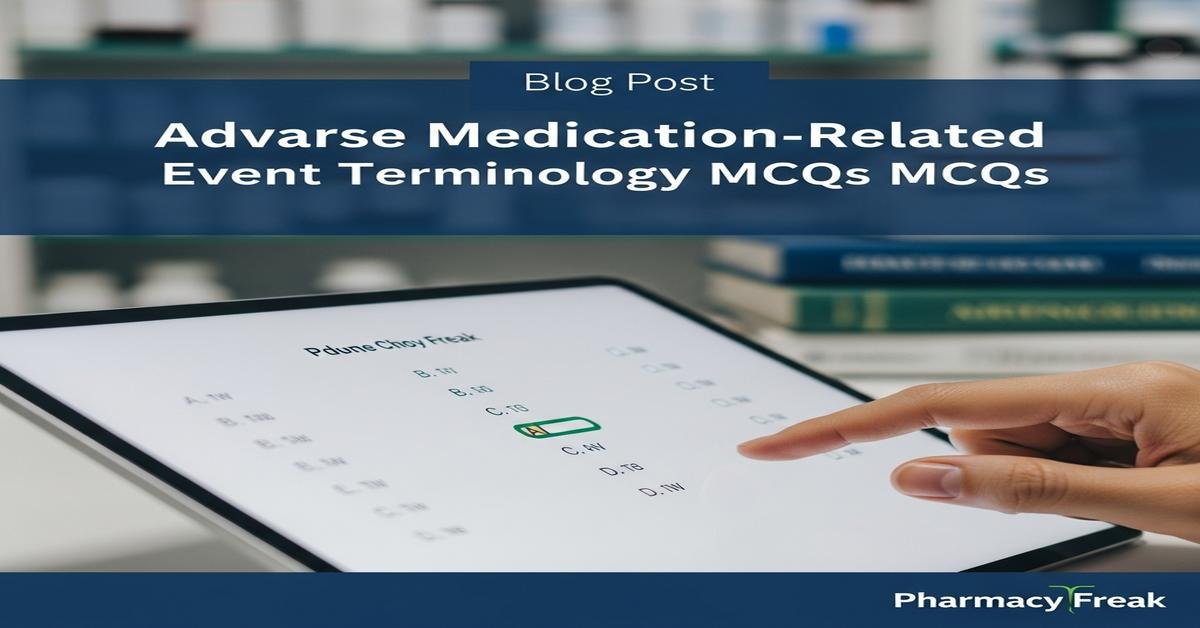Introduction: This focused set of MCQs covers adverse medication–related event terminology to strengthen B. Pharm students’ understanding of key concepts such as adverse drug reaction (ADR), adverse drug event (ADE), medication error, pharmacovigilance, causality assessment, seriousness, and preventability. Questions emphasize classification (Type A–E reactions), reporting systems, dechallenge/rechallenge, signal detection, risk mitigation strategies (REMS, black box), and common pharmacokinetic and pharmacodynamic mechanisms leading to harm. The collection is designed to deepen clinical reasoning, improve identification of sentinel and near‑miss events, and prepare students for real‑world safety reporting. Clear terminology and practical examples help link theory to pharmacy practice. Now let’s test your knowledge with 30 MCQs on this topic.
Q1. Which definition best describes an Adverse Drug Reaction (ADR)?
- An injury resulting from medical management rather than the underlying disease
- An unexpected therapeutic failure due to nonadherence
- A harmful and unintended response to a medicinal product at normal doses
- A predictable side effect that occurs only with overdose
Correct Answer: A harmful and unintended response to a medicinal product at normal doses
Q2. What is the primary difference between an Adverse Drug Event (ADE) and a Medication Error?
- ADEs always cause harm, medication errors never do
- ADEs are outcomes; medication errors are processes that may lead to harm
Correct Answer: ADEs are outcomes; medication errors are processes that may lead to harm
Q3. Which WHO-UMC causality category indicates a reasonable temporal relationship and unlikely alternative explanation?
- Certain
Correct Answer: Probable/Likely
Q4. Type A adverse drug reactions are best characterized as:
Correct Answer: Dose-related and predictable from pharmacology
Q5. Which term describes an adverse event that reaches the patient but does not cause harm?
Correct Answer: No harm incident
Q6. Which scale is commonly used for causality assessment in clinical practice and research?
Correct Answer: Naranjo algorithm
Q7. Which factor is NOT typically considered when assessing seriousness of an adverse event?
Correct Answer: Requires dose adjustment for convenience
Q8. Which of the following is an example of a preventable adverse drug event?
Correct Answer: Drug–drug interaction from prescribing erythromycin with simvastatin
Q9. Dechallenge in pharmacovigilance means:
Correct Answer: Stopping the suspect drug to see if the event abates
Q10. Rechallenge provides useful evidence when:
Correct Answer: The reaction recurs on re‑exposure confirming causality
Q11. Which of the following best defines a sentinel event in medication safety?
Correct Answer: An unexpected occurrence involving death or serious injury
Q12. Which reporting system is maintained by the U.S. FDA for adverse event submissions?
Correct Answer: MedWatch
Q13. Which method is commonly used in pharmacovigilance for signal detection using spontaneous reports?
Correct Answer: Proportional Reporting Ratio (PRR)
Q14. Which is an example of a pharmacodynamic interaction that may cause an adverse event?
Correct Answer: Serotonergic drugs combined causing serotonin syndrome
Q15. Which population is most vulnerable to adverse medication‑related events due to polypharmacy and altered pharmacokinetics?
Correct Answer: Elderly patients
Q16. Which of the following best differentiates an allergy from an adverse drug reaction?
Correct Answer: Allergies are immune‑mediated and reproducible on re‑exposure
Q17. The Schumock and Thornton criteria are used to assess:
Correct Answer: Preventability of adverse drug reactions
Q18. Which term refers to an adverse effect known from a drug’s pharmacology and listed in product information?
Correct Answer: Side effect
Q19. Which is a primary cause of medication errors in hospitals?
Correct Answer: Look‑alike/sound‑alike drug names and labeling confusion
Q20. Which regulatory measure mandates additional risk management for certain medicines in the U.S.?
Correct Answer: REMS (Risk Evaluation and Mitigation Strategies)
Q21. Which laboratory change is most indicative of a Type A predictable ADR from hepatotoxic drugs?
Correct Answer: Rise in alanine transaminase (ALT) and aspartate transaminase (AST)
Q22. An idiosyncratic reaction is best described as:
Correct Answer: Unpredictable, not related to dose, and often rare
Q23. Which action is most appropriate when a serious suspected ADR is identified in practice?
Correct Answer: Report promptly to the appropriate pharmacovigilance authority and document clinically
Q24. Which mechanism explains increased drug exposure when clarithromycin is coadministered with simvastatin?
Correct Answer: CYP3A4 inhibition leading to reduced simvastatin metabolism
Q25. Which descriptor refers to unintended therapeutic failure due to incorrect drug selection or dosing?
Correct Answer: Therapeutic ineffectiveness
Q26. Which is an example of a preventable harm related to anticoagulant therapy?
Correct Answer: Failure to monitor INR leading to major bleeding on warfarin
Q27. Which coding/classification system is commonly used to standardize adverse event terminology internationally?
Correct Answer: MedDRA (Medical Dictionary for Regulatory Activities)
Q28. Which preventive strategy reduces look‑alike/sound‑alike medication errors?
Correct Answer: Use of tall man lettering and separate storage
Q29. Which is true about black box warnings on drug labels?
Correct Answer: They communicate serious or life‑threatening risks and require risk minimization
Q30. Which investigation approach helps identify root causes of a serious medication error in a hospital?
Correct Answer: Root cause analysis (RCA) with multidisciplinary review

I am a Registered Pharmacist under the Pharmacy Act, 1948, and the founder of PharmacyFreak.com. I hold a Bachelor of Pharmacy degree from Rungta College of Pharmaceutical Science and Research. With a strong academic foundation and practical knowledge, I am committed to providing accurate, easy-to-understand content to support pharmacy students and professionals. My aim is to make complex pharmaceutical concepts accessible and useful for real-world application.
Mail- Sachin@pharmacyfreak.com
